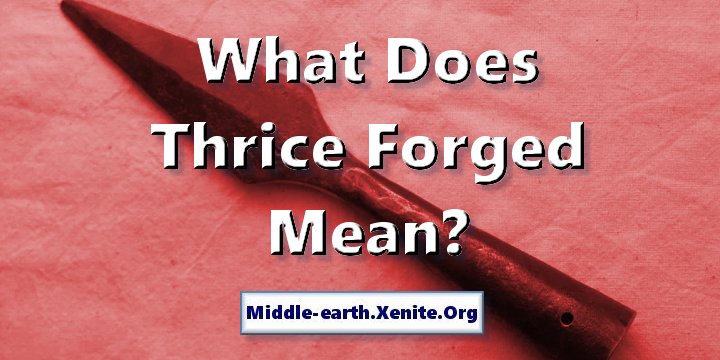
Q: What Does Thrice Forged Mean?
ANSWER: Many of J.R.R. Tolkien’s readers are curious about what he is referring to when he casually mentions the thrice-forged spears of King Bladorthin in The Hobbit. Thrice-forging is a historically attested process developed by ancient peoples in Europe and elsewhere. It is a way of purifying and hardening metals. There are several myths which mention the creation or use of thrice-forged weapons. All of that is wrong. See What Can Be Inferred from Bladorthin’s Spears? for detailed explanations of why “thrice-forging” was a myth.
Forging is the process of shaping metal. Many people assume you have to heat the metal in order to forge it but that is only true of a metal that cannot be shaped through a “cold” forging process. Forging metal changes its internal structure, thus strengthening it. Think of aligning the internal flows of a piece of metal to all point in the same direction. These “flows” are the grain of the metal. Changing the grain of a metal to flow in the desired shape makes the forged metal object stronger.
Part of the forging process is the cooling or recrystalization that occurs as a result of cooling. Smiths may try to cool a forged metal rapidly in movies but it’s my understanding that a smith wants to control the cooling process to prevent the metal from becoming too brittle. A poorly forged artifact could be reforged to repair such defects.
Ancient smiths often had to smelt their own ores, heating them and beating them to separate the metals from “slag”, the other minerals or materials found in the ores. The smelting process is thus sometimes associated with forging in the popular imagination but forging was always the act of shaping the metal.
Reforging an artifact might indeed help strain out some of the impurities (assuming you could heat the metal enough) but would also improve the alignment of the grain. One side effect of reforging might be to actually weaken the metal. For example, if you attempt to reforge a rusty sword you’re forging the weak oxidized iron into the new shape. The difficulty presented by rust may explain why so many ancient weapons have been found from times when iron was in short supply and high demand. If the smiths lacked the skills and the resources to purify rusted iron it would have been useless to them.
In mythology and fantasy, the art of forging is often associated with magic or the powers of gods and other non-human beings. Tolkien’s Elves and Dwarves, and even his Numenoreans, appear to have had magic-like capabilities that assisted them in the forging process. Hence, Bladorthin’s “thrice-forged spears” might have been merely superior weapons but it’s conceivable that Tolkien also meant they were magical (since they were made by the Dwarves of Erebor, who were clearly capable of making magical things).
In Middle-earth the act of thrice-forging an object might have included imbuing it with “the maker’s thought” or power in each forging process, thus strengthening the “power” of the object. We know from some European traditions, particularly among Vikings, that weapons were often given names or had special phrases engraved upon them, such that their makers conveyed a certain will or desire toward achieving victory in battle or over enemies.
See Also
Why Weren’t Bladorthin’s Thrice-Forged Spears Delivered?
How Large Was the Kingdom of Dale’s Army?
How Many Soldiers Fought In the Battle of Five Armies?
What Kind of Army Did the Beornings Maintain?
# # #
Have you read our other Tolkien and Middle-earth Questions and Answers articles?
